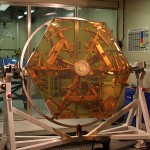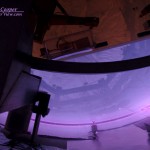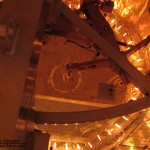A telescope relies on the quality of the primary mirror. The shape must be exquisite perfection, with errors measured in millionths of a meter. The reflective coating must also perform to high standards, reflecting well over 90% of the light across a wide region of the spectrum.

Keck uses pure aluminum to coat the surface of each mirror segment, chosen for its excellent reflectivity in the visible and infrared parts of the spectrum. It takes only 20.5 grams of aluminum to coat an entire Keck primary mirror. This thin layer of aluminum degrades with time, losing several percent of it’s reflectivity each year. Eventually it must be replaced.
Re-coating a mirror is a painstaking process of stripping the old coating, carefully cleaning the mirror, the placing the mirror in a vacuum chamber to deposit a new metal coating onto the glass. The process takes about a week per segment, with one full time technician dedicated to the task, with a little help to handle some of the more intense parts of the process.
An advantage of a segmented telescope is that individual segments may be swapped in a single day. Telescopes utilizing monolithic mirrors must shut down for weeks to remove the primary mirror, strip clean and re-coat. With spare segments available the maintenance crew can perform the task of re-coating on a reasonable schedule, without taking the telescope off sky for an extended period.
At Keck there is a special storage facility for segments awaiting re-coating and those that are ready for installation back into the telescope. The process is continuous, once the last segment is finished, it is time to start the rotation again.

Once cleaned the mirror is moves to a large vacuum chamber where the new coating will be deposited. Here the mirror is positioned face downwards. With the cover reinstalled on the chamber it will take most of a day to pump out the air and ready the chamber for coating.
Glow discharge is a method of cleaning a surface prior to vacuum coating it. A high electrical charge is placed on an electrode just below the mirror in a partial vacuum. The result is something like creating a storm of electrons to blow any remaining impurities off the surface of the mirror. It is also a very beautiful process, looking through the ports one can see a brilliant violet haze around the electrode with sparks flickering along it’s length.

The coating process takes only a few minutes once the electrodes are turned on. Peering in through the small view port a cheery red glow is seen from each of the electrodes at the bottom of the chamber. The view only lasts a few moments as the cloud of vaporized aluminum soon reaches the view port and the glow fades as the window is covered by a layer of deposited aluminum along with the mirror segment.
What emerges from the chamber is a mirror with a beautiful, reflective metal coating. A few tests will be performed to insure the coating meets specification. If all is well the mirror segment will be prepared for installation in the telescope. It will await another segment exchange when it will replace another segment that has become dull with years of exposure to the elements. That segment will then receive it’s turn in the coating chamber.

